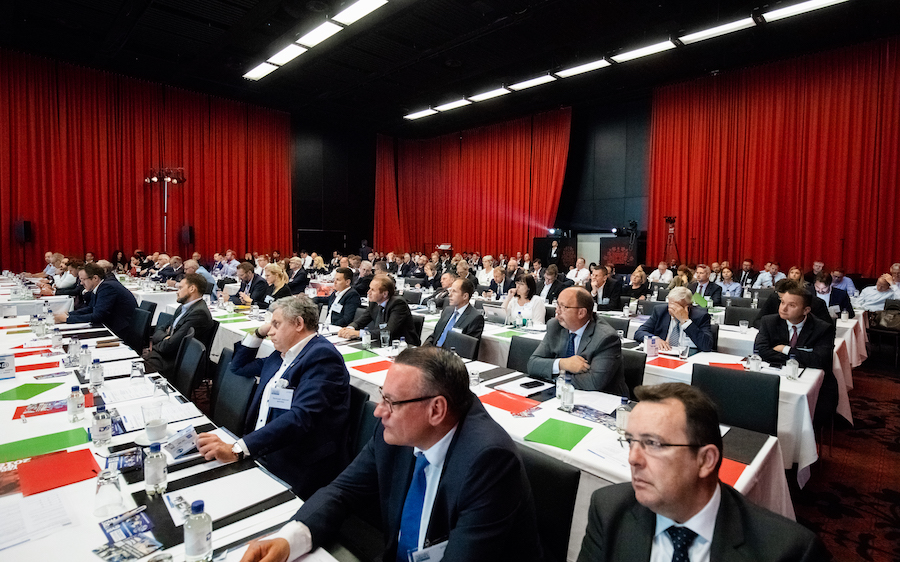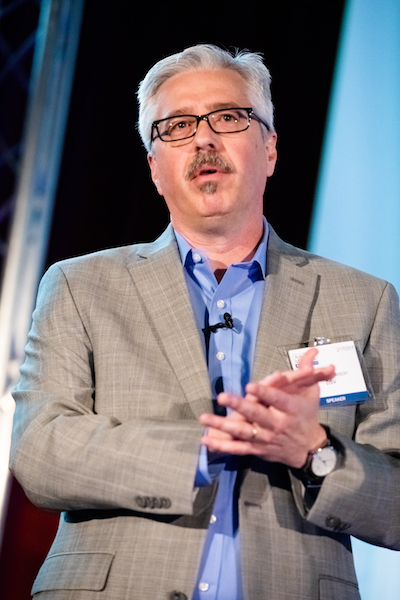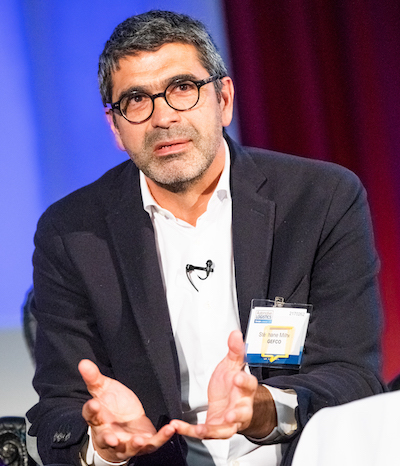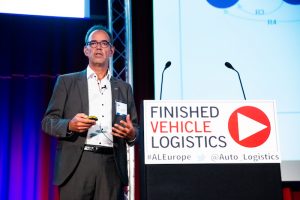 The rate at which emerging digital technologies are transforming the automotive logistics supply chain is hard to keep up with. As both an enabler of everything from platform design to procurement, finance and planning, and a disruptor of traditional supply chain operations, digital technology associated with industry 4.0 is driving down process time and speeding up innovation. However, digital technology is not an end in itself and is only an enabler of process improvement when driven by the talent of a creative and educated workforce.
The rate at which emerging digital technologies are transforming the automotive logistics supply chain is hard to keep up with. As both an enabler of everything from platform design to procurement, finance and planning, and a disruptor of traditional supply chain operations, digital technology associated with industry 4.0 is driving down process time and speeding up innovation. However, digital technology is not an end in itself and is only an enabler of process improvement when driven by the talent of a creative and educated workforce.
That marriage of technology and talent was one of the central points of discussion at this year’s Automotive Logistics Europe conference, held in Bonn, Germany, last week.
The dynamic between human ingenuity and the development of technology optimising logistics processes across the automotive industry was given added impetus at this year’s conference with the launch beforehand of the Automotive Logistics Awards – Europe. On the evening before the conference began, 14 awards covering every aspect of inbound, outbound and aftermarket logistics were handed out to carmakers, suppliers and logistics providers who were judged to have shown excellence and innovation. Among those walking away with trophies were vehicle makers Seat and Volvo Cars, tier supplier Magna Steyr, logistics service providers Gefco and time:matters, and technology providers Fracht SIA and CEIT.
Better visibilityOpel/Vauxhall and its fourth-party logistics provider 4flow received the Better Visibility award for the development of the Transportation Control Centre the carmaker is now using to provide transparency on the service parts supply chain. During the conference which followed, Kai Rabe, European manager of aftersales logistics at Adam Opel, talked about the company’s work with 4Flow on the control centre in more detail.
He explained that the starting point for the project came from a lack of visibility in the overall Opel/Vauxhall aftersales supply chain from materials procurement to the dealer/service centre.

That lack of process transparency was resulting in a high number of overshipments, poor truck utilisation and a lower consolidation level, according to Rabe.
Opel had to come at the problem initially without resource to any dedicated IT or a team to implement the improvements, and without interfering with the existing system transport management system (TMS). Rabe explained that the team went to the market and eventually awarded a contract to 4flow.
“We knew we had a lack of transparency but knew roughly where we wanted to go and how we could get there with a flexible partner,” said Rabe. “We had some ‘play money’ to work with but also we had the challenge that we had to show a return on investment very quickly. We always had to find a balance in investment and continued development with showing wins along the way.”
The Transport Control Centre has now eliminated supply chain fragmentation in the OEM’s network and provided high levels of visibility.
“We involved all the partners, which was a key issue,” said Rabe, pointing to the importance of collaboration in getting results. “It took a long time and lot of convincing. We have enhanced this process with the empty flows as well and now can measure everything; we are now at 90% of flow in the system.”
Digital accelerationThis service and Gefco’s winning solution in the Innovation Leader category (see FVL section) were two that fit well within the overall discussions at this year’s conference, which focused on how digital technology is accelerating the pace of change in the automotive industry and how interconnected digital systems are becoming.
Wolfgang Lehmacher, head of supply chain and transport industries at the World Economic Forum (WEF), said it was the very interconnectedness of these systems and the exchange of data that was favourable to innovation
“Data is the oil of the digital economy,” said Lehmacher and the way to get the real value out of automation is through a fully connected digital system. Innovation based on digital interconnectedness was most likely to flourish in cities, he added.
“You need dense locations, highly educated people and those who are smart and creative, and can make things happen,” said Lehmacher. He pointed to the Gateway Project in London, which deployed driverless pod shuttles for moving people around Greenwich, and the first deployment of self-driving vehicles in Singapore as examples where innovation had flourished.
“You have to expose your people and organisation to this new world; it is a world that is revolutionary,” he said, indicating the diverse set of technologies affecting the supply chain, including AI, blockchain and advanced analytics, which were coming together in new ways. He also pointed to digital technology’s role as an enabler for financing innovation, cutting the time it took to secure funding for companies from weeks to hours, something he said was leading to a “democratisation of financing”.
“The World Bank estimates that the trade finance available is $1.5 trillion and there are start-ups now saying that you don’t need a letter of credit at all,” he said.
Digital technology also has a significant role to play in procurement, something that was picked up by Björn Klippel, CEO of Tim Consult, who said it was a question of how companies reacted to disruptive markets that determined whether they would survive.
“We have to find new ways of procurement, planning and operation,” he said. “The next question is: can we do things differently, more easily, with less headcount and faster, using more fact-based decision-making through the use of technology?”
At the same time that new technology associated with industry 4.0 is bringing radical change to the industry, regulation is exerting a certain control, especially in Europe, where for instance, carbon emissions are to be cut in half by 2050. That control helps focus innovation, however, according to Lehmacher.
“Smart places remove boundaries to get innovation going and then narrow them to focus it,” he said, citing the Yara Birekeland project as an example of the industry responding to the need for cleaner transport with new technology.
 Wolfgang Lehmacher, head of supply chain and transport industries, World Economic Forum
Wolfgang Lehmacher, head of supply chain and transport industries, World Economic ForumThe Yara Birkeland is an autonomous, zero-emission container ship that will replace 40,000 diesel-powered truck journeys between three ports in southern Norway.
Collaborative intelligenceGreg Slawson, global vertical lead for automotive at DSV, one of the world’s top five logistics providers, also alluded to the sheer velocity at which technology was developing, suggesting that it was important to understand, through long-term partnerships with the technology providers, what it was a company actually needed to achieve.
That point was shared by Klippel, who acknowledged that while the industry was currently flooded with information, the key was having the intelligence to understand what exactly was going on and how technology could be used to succeed in the market. Technology was not a solution in itself, stressed Klippel.
“If you have a sub-optimum strategy and process, and you put IT systems in without changing anything else, all you have is a more expensive sub-optimum process,” he said. “Just implementing devices to track or carrying out timeslot planning without changing how the goods-in-process works, or failing to draw conclusions on how we procure, [just means] nothing will happen.”
Klippel saw joint decision making as a ‘megatrend’ and collaboration was also crucial in establishing freight and supply chain platforms with new technology, according to DSV’s Slawson, who said the company was looking for more meaningful relationships with a smaller number of core providers of that technology.
“It starts with understanding what it is we need today that the platform can provide but also having a long-term commitment to share the strategy,” said Slawson. “If my software provider is going in a different direction than I am and we don’t understand that, then two or three years down the road, we are going to have a big gap and compromise our ability to perform our core mission with that platform.”
What improved the ability to perform, he added, was greater visualisation of processes – important for a company that makes 80% of its bookings digitally. “If you can’t see it, you can’t manage it,” said Slawson, adding that outdated systems could not provide the real-time data that was crucial to faster decision-making or problem-solving.
“The sooner we know about the problem, the sooner we can fix it quickly,” he said, adding that it was important in this day and age to disrupt siloed systems that prevented all those involved in the supply chain from seeing the same thing. That was important for DSV, which through its history of acquisition – 50 companies bought in about 40 years – meant it had inherited a lot of different IT systems that were often doing the same thing.
“We talked about accelerating innovation and putting our investment where it needs to be, but one of one of the first things you have to do is rationalise what you have today,” he said.
What was also important for Slawson was a willingness to risk failure in the search for the next solution.
 Greg Slawson, global vertical lead for automotive at DSV
Greg Slawson, global vertical lead for automotive at DSV“We want to try different technologies and we are willing to fail,” he said, adding that a company can learn quickly through its failures as long as they happen early and investment is not wasted over a drawn-out project that eventually fails anyway. He also said it was important to minimise the impact of the failure. “We want to fail fast and fail small,” said Slawson.
War for talentAs a number of speakers pointed out at this year’s conference, the technology being developed is only as good as the people using it and securing talented users of the latest tools is just as important to a company’s success. However, there is a currently a war for talent going on in the automotive supply chain at both shopfloor and managerial levels, added to which is the fact that new tech companies, such as Apple and Amazon, are syphoning off the available talent as soon as it becomes available.
Stéphane Milhet, human resources vice-president at Gefco, said that attracting talent to the logistics and supply chain industry was becoming increasingly difficult – though he said the carmakers with strong brands fared better and that generally, the image of the supply chain engineer as a viable profession was improving.
“We are making it more attractive because we deal with extremely complex solutions and this is extremely appealing,” said Milhet.
Holding on to the talent that is attracted to the complex problems of supply chain thinking and getting the best out of the workforce depend on creating an organisational climate in which innovative thinking is central to the day-to-day running of a business – and that depends on good leadership, said Jorg Blechinger, director of logistics at tier supplier and contract manufacturer, Magna Europe, who said he thought of it as an orchestra.
“Every one of the musicians is good – the key is bringing the individual talent together and we have to bring all the players in the supply chain together,” he said.
Opel’s director of logistics and container management, Andreas Graffe, said it was important to secure both experts who could focus on complex jobs and those with leadership skills who could look more broadly at the various elements affecting the business; it was very much a case of combining skills, he said.
Luckily, supply chain and logistics had a lot to offer, said Graffe, and engineers were attracted to both the complex problems the job throws up and the breadth of subject matter covered, including financial responsibility.
He said it was important to focus on attracting people from the universities with an educational background in supply chain or logistics management but also in related subjects such as IT. As important, he suggested, was recruiting people during their academic career and giving them a complex supply chain problem to solve, both to get them interested and to make them understand the complex issues behind the job.
“Diversity is also important,” said Graffe. “They should bring creativity and new ideas to the job. There should be a mix of experts and people from other areas with new ideas, and links between the supply chain organisation and other areas of responsibility.”
Creative understandingBlechinger said that, regardless of the leaps being made in technological innovation, people were still the key to the success of the business, though areas of responsibility were changing and there was a demand for specialists that understood a more complex supply chain and the tools being developed to run it.
“People need to have a creative understanding of deep processes, even if our technology already supports those processes,” he said.
Blechinger suggested, however, that the education system was not aligned with what was needed in future.
Andreas Subbe, director of automotive SCM at tier one supplier Continental, said that his company was looking for data analysts because of the amount of activity related to industry 4.0 technology.
 Andreas Graffe, director of logistics and container management, Opel
Andreas Graffe, director of logistics and container management, Opel“There is a high demand for predictive analytics,” said Subbe. “Getting predictions out of data is a big area. Industry 4.0 covers a lot of things and there is going to be a big need for this talent.”
Subbe said there had been concerns over how industry 4.0 automation was threatening jobs and Continental had been in discussions with the unions to address these concerns. To take one example, there is a greater shift to automated guided vehicles in factories and warehouses, which of course has an impact on the need for forklift truck drivers. Subbe said it was important to move people into the new jobs that were coming with the spread of automation, and that included all age groups.
“There is always diversity, not just in gender but in age, and that drives teams to the best performance,” said Subbe. “There are a lot of ideas coming out but if we only look at the young entrepreneurs then we are missing the chance to get the knowledge [that comes with the more mature worker] into play.”
Electric vehicle technology is also having a disruptive effect on the wider supply chain and logistics industry, with the potential to affect jobs. WEF’s Lehmacher pointed out that the EV was not just a vehicle with a different engine, but something that constituted a system shift in the automotive business overall. That included repercussions for parts engineers and the service sector, as well as sales.
“There are fewer parts to put in and fewer engineers needed to build them,” said Lehmacher. “There are fewer moving parts, which means fewer to service, so the service side of the business will suffer.”
 Stéphane Milhet, human resources vice-president at Gefco
Stéphane Milhet, human resources vice-president at GefcoLehmacher said that because the EV lasted three times as long as a car run on a traditional combustion engine, there would be fewer cars sold, with the implication that there would be fewer people needed to sell them; meanwhile, the fact that online sales have grown so dramatically also negates the need for such a big dealership staff.
“If there are fewer cars sold you will need fewer car carriers on land and sea,” added Lehmacher. “You need fewer spare parts and less oil, depending on where the energy comes from. So multiple systems are affected.”
That said, new ownership models and ride-sharing may in fact increase the time that a vehicle is used, leading to an increased demand for replacement parts and shortening the vehicle’s lifecycle.
Opportunities in changeAsked whether there was uncertainty over at Opel, given the fact that Groupe PSA bought the ex-GM division last year, Andreas Graffe acknowledged that the carmaker was changing its set-up and aligning the way it did business with PSA. However, he said the team was looking for opportunities in the change.
“Everyone needs to be adaptive and there is no industry that is standing still,” said Graffe. “You don't just do things the same way you did for 20 years. Everyone has to become more familiar with the fact that things are changing and they have to adapt to it and see it in a positive manner.”
Graffe said communicating that change was positive was one of the main things company leaders had to do in times of transformation. “We need to make sure the people see this in a positive manner, and give them the ability to adapt to change and bring their own ideas into the evolution,” he said.
One of the other big problems for the automotive logistics industry at the moment, not just in Europe, is a fast diminishing driver pool. Technological answers such as autonomous delivery vehicles are still a way off. What needs to be done is make the job more attractive and Milhet said Gefco had had some success here. One of the main things the company has done was make the trucks drivers use on the outbound side more attractive, he said.
“In France we had major difficulties in attracting drivers,” said Milhet. “It was not a question of salary – 90% of the issue was what sort of truck they would be driving.”
Adding comfort features to the trucks, including a larger sleeping area, also helped, as did improving general working conditions. “Making drivers work in all weathers [loading and unloading finished vehicles] is not acceptable and increases the rate of accidents and damage,” said Milhet.
Gefco invested in a fleet of 150 new trucks from “a major German truckmaker” and suddenly people were knocking on the door looking for work, according to Milhet – another example of how closely linked people are with the technology they use and how business depends on that relationship working.
The technology issues stimulating the most debate in terms of finished vehicles at this year’s conference centred around supply chain visibility and tracking, a subject that is a lot more complex than many would believe, according to Torsten Heinrichs, manager of vehicle logistics – continent at Ford.
“Allegedly, finished vehicle logistics is a simple business,” said Heinrichs. “We only ship vehicles from A to B, right? In reality the complexity of our business is increasing day after day. There are more supply chains and cross-continent shipments for Ford and the other OEMs.”
 Torsten Heinrichs, manager of vehicle logistics – continent at Ford
Torsten Heinrichs, manager of vehicle logistics – continent at FordTo back this up, Heinrichs focused on Germany, comparing the 550 suppliers from which Ford picks up parts and component systems on a daily basis for global distribution with the 650 delivery locations to which it moves finished vehicles from within and beyond Germany. Delivery schedules to those locations are varied and come from a range of origins, including plants, ports, compounds and vehicle distribution centres (VDCs).
Such complexity of outbound supply was confirmed by Hartmut Haubrich, director of finished vehicle logistics at logistics software provider Inform, who pointed out that a car was not like a parcel going from A to B but had a lot more potential diversions along the delivery process.
“There are various things that can happen in the chain, be it planned action such as modification, homologation or accessory fitting, or unplanned action such as the return of vehicles that the dealer does not accept,” said Haubrich. “There are lots of things going on in the finished vehicle supply chain and a lot of effort is going into the question ‘where is the vehicle?’. However, there are no common standard EDIs [electronic data interchanges] to communicate that.”
Cost and collaborationHeinrichs agreed that this complex environment was not served by an adequate level of transparency and that the resources spent on operating a network that was not properly connected were high.
“We know where our vehicles are in the supply chain but currently, the transparency that we get requires a lot of effort from all the parties,” added Heinrichs.
Carriers and suppliers spend a lot of time and resources providing these messages manually, as well as following up on missing or incorrect messages and cleansing data. At the same time, there is a fight for precious resources given the various demands hitting the industry at the moment, including rises in fuel (even bunkered fuel) prices, driver and equipment shortages, lack of compound space and increasing regulation.
 Veronika Söntgerath, connected mobility executive consultant in the Digital Division at T-Systems
Veronika Söntgerath, connected mobility executive consultant in the Digital Division at T-Systems“These are factors on which we have limited or no influence and yet still our customers want us to become more efficient and precise every year,” said Heinrichs.
The answer, once again, was in better collaboration, he suggested. “We need to increase our joint efforts to take waste out of the supply chain,” he said. “This is less about cost and more about efficiency.”
Ford is now building a new Focus model at its Saarlouis plant in Germany that has an embedded modem to provide timely and accurate status messages on where the vehicles are in the supply chain. It is working with global IT services and consulting company T-Systems and logistics software expert Inform on a pilot for tracking vehicles on a delivery route to Ireland that Heinrichs said he was hoping could be rolled out to the rest of the business.
“This tech will enable us to provide accurate, real-time information on end-to-end vehicle delivery to identify and drive out variability and waste,” he said. “Imagine the efficiency if no manual updates were required across all of our intercontinental supply chains. I truly believe that the winners will be the ones supporting us in achieving these improvements, taking waste out of the supply chain to improve the service we provide for our customers.”
Plug and playVeronika Söntgerath, connected mobility executive consultant at T-Systems’ Digital Division, explained that her company had been working on extending the scope of this in-car technology with the introduction of a SIM card to its OBD2 adaptor that plugs into the standard interface in the car that the dealers use for diagnostics.
“You want to know about the health of the car, the battery status, [and] any damage,” she said. “All of this can come out of this [adapter] solution.”
She said the data gathered from the OBD2 system would be stored on T-Systems’ centralised platform and delivered to Inform. T-Systems has completed the first proof-of-concept trials and is working with several OEMs, including Ford, with a view to using the technology for visibility and tracking in the outbound supply chain.
Inform’s Haubrich explained that the system collected GPS information and, once received via the T-Systems platform, Inform focused on visualising it and refocusing attention and resources on planning rather than finding out what was happening at any one point in the supply chain.
“The actual status in now automated, so lots of resources get freed up and can be focused on what should be happening,” he said. “[Systems like this] will reduce or eliminate the effort to find where the vehicle is and the people working today on that can concentrate on where it should be and what needs to be done to get it there.”
Narrowband IoTSöntgerath said the outbound logistics sector was set to radically change with digitalisation and one of the most important things for it was narrowband Internet of Things (IoT) technology. Unlike RFID technology, there is no need for expensive sensor gates or antennae using such technology.
“It is a game-changer for logistics,” she said. “It makes it possible to track and get information about the status of [vehicles] for a really low cost. These sensors can cost less than €10 ($11.5) and have an extremely long duration of battery, which can last five or ten years.”
 Hartmut Haubrich, director of finished vehicle logistics, Inform
Hartmut Haubrich, director of finished vehicle logistics, InformNarrowband IoT technology connects directly with the telecoms networks, such as LTE, the forthcoming 5G network, and GSM.
“Narrowband IoT will be something we will talk about a lot further on because it is really making things viable that we haven’t dreamed about solving before.”
One other thing that was crucial to the adoption of the technology and the way T-Systems was developing it was the fact that it had a global infrastructure.
“The automotive industry would not be interested in a solution that only covered one country – it has to be worldwide,” observed Söntgerath. “This is why we use our telecoms system with roaming and with M2M partners across the world, to make this tracking viable wherever the vehicles go to be delivered.”
T-Systems is just one of a number of experts helping to improve tracking technology and as systems proliferate and tech companies contend in their provision of services to enhance visibility in the outbound sector, so the need for standardisation increases.
Haubrich said there was already a lot of communication going on within different fields, all with their own meanings.
“There is room for standardisation in the automotive logistics ecosystem,” he said. “We should be in control of what we are developing in that system.”
Untapped marketOne other example of where digital technology was being applied to track finished vehicles was seen in logistics provider Gefco’s app for single-car transport services – MyCarIsThere. The solution won an award at the Automotive Logistics Awards – Europe 2018 ahead of the conference and later, Kamil Mezynski, sales director at the company, explained more about the service and how Gefco is moving into new areas of business.
 Kamil Mezynski, sales director, Gefco
Kamil Mezynski, sales director, GefcoGefco typically handles new vehicle shipments in large volumes and last year moved almost 2m units. However, there were 45m used cars sold across Europe last year and, according to Mezynski, 70% of people are ready to buy those vehicles on the internet. In response, Gefco has developed a simple app for individual second-hand vehicle pick-up and delivery, currently for use by rental companies, used car traders and auctioneers, with a view to individual buyers eventually also using it.
Customers use the app to ask for a quote and then order the transport, providing information on the sort of car, where Gefco is supposed to pick it up, and where it is to be delivered. “Within minutes you get a quote; if you accept that, then you add information including the number, and then you can also choose level of service,” explained Mezynski.
Rather than dealing with the large vehicle carriers, Gefco is using towing companies and individual jockeys to move the cars.
“This application is completely new in the way Gefco is approaching the business,” said Mezynski. “It is a different model starting from the customer side, and from the sourcing and finance angles. You have to receive the payment from the private individual and to be able to pay the individual driver who is moving the car. It means going from the movement of major volumes in an industrialised way to individual moves at different times. We think it meets the changing needs of mobility.”
Mezynski added that it was just the beginning for the app and that the range of services the app provided had scope for expansion into predictive maintenance, tyre changes and refuelling.




Automotive Logistics Europe is part of the global Automotive Logistics series of conferences.
The next event, Finished Vehicle Logistics Import Export, will be held on August 7-8 in Baltimore, MD, USA
Topics
- Data
- Digitalisation
- Digitalisation
- DSV
- Electric Vehicles
- Europe
- features
- Finished Vehicle Logistics
- finished vehicle logistics
- inbound logistics
- Inbound Logistics
- Inbound parts
- Industry 4.0
- IoT
- IT
- Materials handling
- News
- Policy and regulation
- RFID
- Start-ups
- Stellantis
- Suppliers
- supply chain IT
- supply chain management
- Supply Chain Planning
- Track-and-trace
- UPS
- Volvo Cars


























![Global[1]](https://d3n5uof8vony13.cloudfront.net/Pictures/web/a/d/s/global1_726550.svgz)












